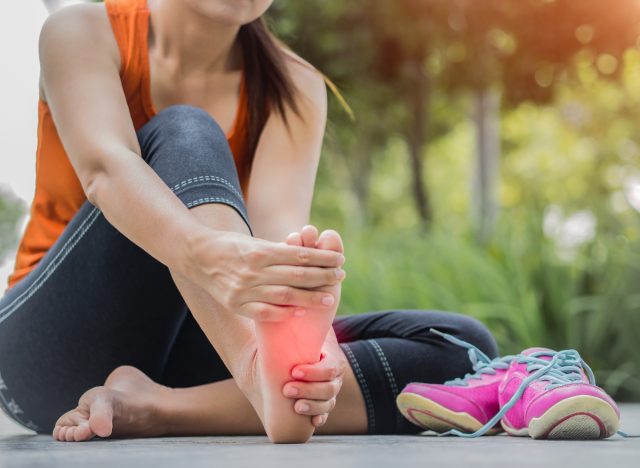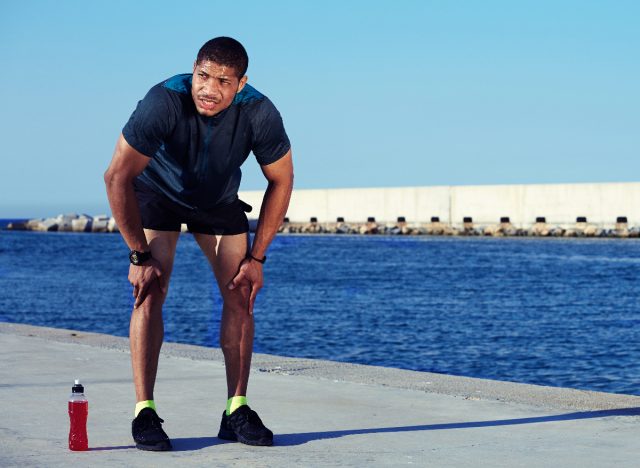There’s no doubt that going out for a run is good for the mind, body, and soul. Along with giving your body an invigorating workout, running can boost your cardiovascular health, memory, sleep, energy, and mood, according to WebMD. Plus, if you hit the trails or go around your neighborhood for a run, you’ll enjoy a healthy dose of fresh air. Now that we know the pros of this form of cardio, are you aware of the dangers of running for exercise?
Just like any form of physical activity, you need to make sure you’re running in a way that’s both safe and efficient. Otherwise, you may end up suffering various injuries or even permanent damage to your body. For instance, be sure to check out the following insight on the dangers of running for exercise, according to Dr. Matt Tanneberg DC, CSCS, a sports chiropractor, certified strength and conditioning specialist, and the owner and operator of Body Check Chiropractic & Sports Rehabilitation in Scottsdale, Arizona. Dr. Tanneberg shares with us everything you should be aware of before hitting the pavement or hopping on the treadmill.
Keep reading to learn more, and next up, don’t miss The Best Indoor Cardio Workouts To Increase Stamina as You Age.
Long-term wear and tear


There are various ways you can make running much safer. You might opt for supportive running shoes and wear clothes that’ll keep you from overheating or feeling too cold. You may also monitor your heart rate via a fitness tracker and stick to challenging yet non-strenuous routes. However, all of these habits may not prevent certain health issues if you’ve been running for weeks, months, or even years.
“The constant impact from ‘pounding the pavement’ will wear down the joints of our body quicker than otherwise,” Tanneberg says. “Running puts a lot of stress and pressure on our lower extremities which can, over time, start to make the feet, ankles, knees, and hips degenerate.”
Short-term injury
Even if you’ve only been running for a relatively short amount of time, you could still be at risk of unfortunate injuries. Every time you indulge in a jog or a sprint, you’re increasing the amount of physical activity you’re tackling at a high rate and pace.
As Tanneberg puts it, “Runners are using their bodies, especially their legs, more than the average person. This will simply put runners at a higher risk for soft tissue injuries (most commonly muscular strains) to the lower extremities than non-runners.”
READ RELATED: A Motivating Playlist to Power Your Morning Workout
Overuse injuries
The increased amount of physical activity runners ask their bodies to endure can also lead to other kinds of injuries you should be aware of. Whether you’re a new runner or have been a marathon-worthy runner for ages, you can find yourself in trouble if you attempt to do too much in a short amount of time.
“Runners are extremely likely to develop some sort of ‘overuse’ type injury, most commonly plantar fasciitis, shin splints, and runner’s knee,” Tanneberg says. “These injuries primarily deal with inflammation impacting tendons from the constant up and down to the pavement.”
Overtraining


If you’re passionate about running, you may work it into your routine as much as possible. However, too much of anything is never a good thing, and you don’t want to overdo it.
Tanneberg says, “Exercise, by definition, puts strain on our muscles, our tendons, our ligaments, and our organs, and in response, our body will recover and become stronger. However, there is a balance of ‘too much of a good thing.’ Overtraining is an issue for runners who don’t mix up their routine by incorporating different activities into their regimen.”
Muscle imbalances
Being a loyal runner can also backfire if you don’t work out in other ways on a regular basis. Tanneberg points out, “Running will develop the musculature of the lower extremities, as well as the core, however, it will not develop muscle tone in the upper body in the same way. This type of muscle imbalance in our bodies puts us at more of a risk of injury, whether that imbalance is top versus bottom, left versus right, or front versus back.”
That’s why, in addition to running, Tanneberg recommends testing out rowing, swimming, biking, or lifting weights on occasion.
Source:










